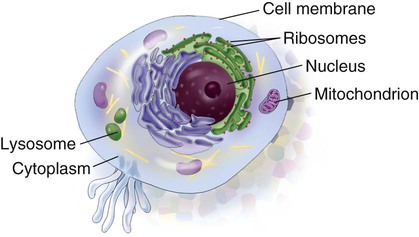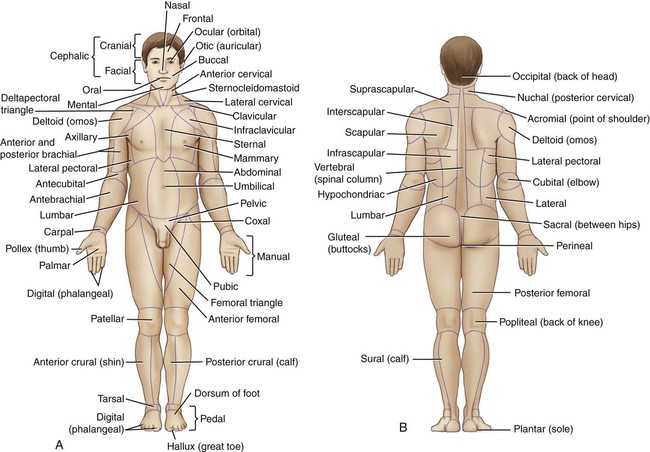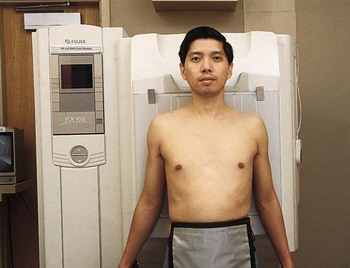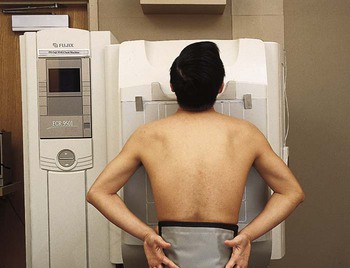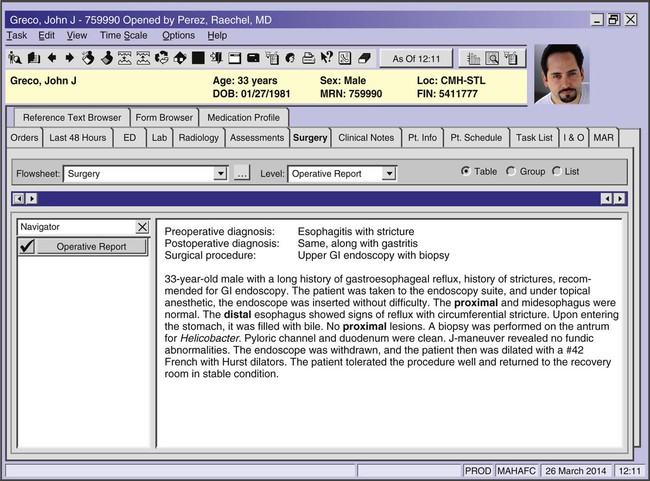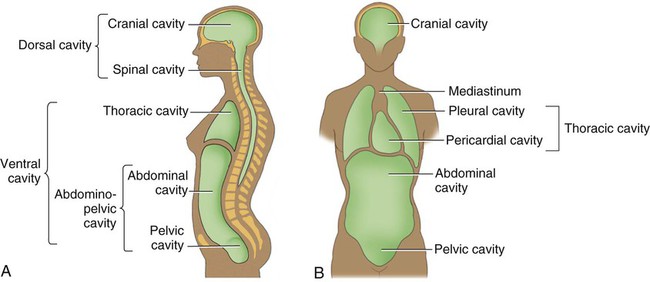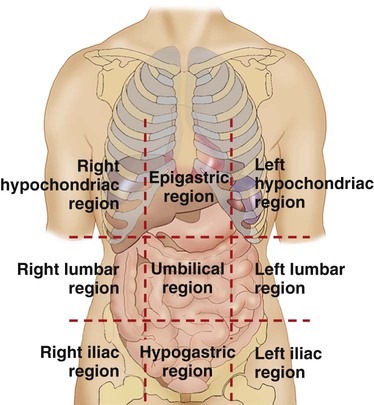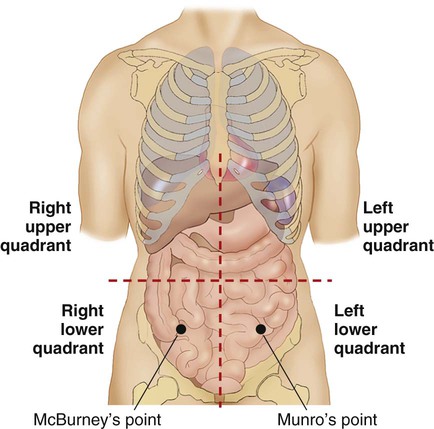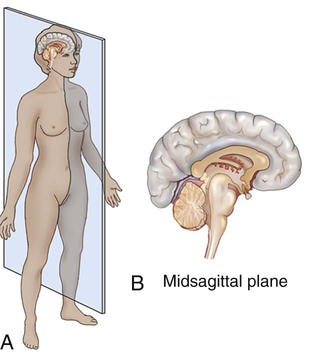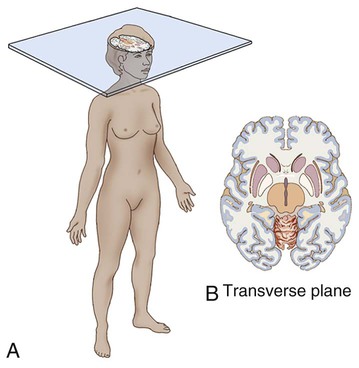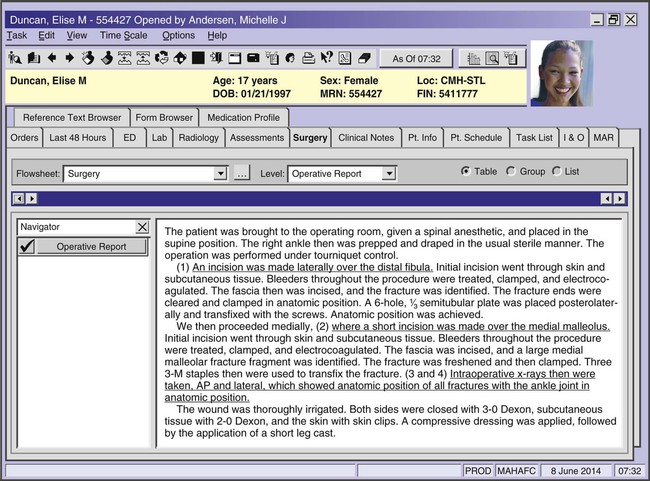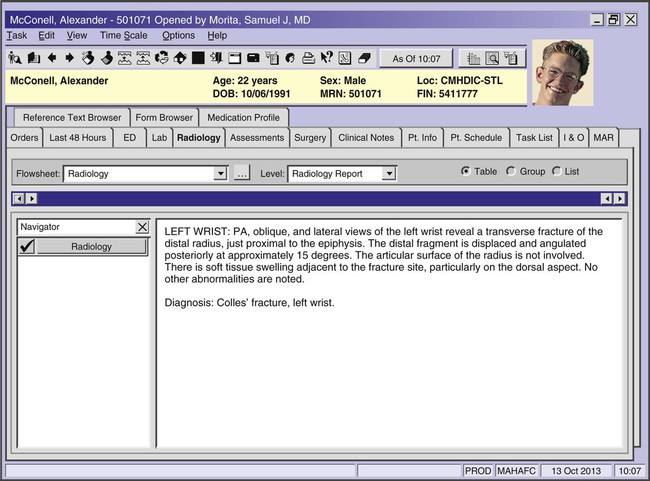Body Structure and Directional Terminology
ICD-10-CM Example from Tabular
S31.600. Unspecified open wound of abdominal wall, right upper quadrant with penetration into peritoneal cavity A
S31.601. Unspecified open wound of abdominal wall, left upper quadrant with penetration into peritoneal cavity A
S31.602. Unspecified open wound of abdominal wall, epigastric region with penetration into peritoneal cavity A
S31.603. Unspecified open wound of abdominal wall, right lower quadrant with penetration into peritoneal cavity A
S31.604. Unspecified open wound of abdominal wall, left lower quadrant with penetration into peritoneal cavity A
S31.605. Unspecified open wound of abdominal wall, periumbilic region with penetration into peritoneal cavity A
S31.609. Unspecified open wound of abdominal wall, unspecified quadrant with penetration into peritoneal cavity A
Organization of the Human Body
Cells
< ?xml:namespace prefix = "mml" />

See Fig. 2-1 for an illustration of a cell and the corresponding table below for a brief description of the pictured organelles and their functions.
| Cell Part | Word Origin | Function |
| cytoplasm | cyt/o cell -plasm formation |
Holds the organelles of the cell. |
| lysosome | lys/o dissolving -some body |
Organelle that serves a digestive function for the cell. |
| ribosome | rib/o ribose -some body |
Site of protein formation; contains RNA. |
| mitochondrion (pl. mitochondria) | mitochondri/o mitochondria -on structure |
Converts nutrients to energy in the presence of oxygen. |
| nucleus (pl. nuclei) | nucle/o nucleus -us structure |
Control center of cell; contains DNA, which carries genetic information. |
Tissues
Epithelial: acts as an internal or external covering for organs, for example, the outer layer of the skin or the lining of the digestive tract. Note that the derivation of the term includes a combining form for the nipple (thel/e). Originally the term epithelium was used to describe the membrane covering the nipple. Later, the usage was expanded to include all surface membranes, whether on the skin or mucosal membrane surfaces, that communicate with the outside of the body.
Connective: includes a variety of types, all of which have an internal structural network. Examples include bone, blood, and fat.
Muscular: includes three types: heart muscle, skeletal muscle, and visceral muscle, all of which share the unique property of being able to contract and relax.
Nervous: includes cells that provide transmission of information to regulate a variety of functions, for example, neurons (nerve cells).
When tissue is destroyed by disease or trauma, the possibility of tissue replacement may be an option. Autologous tissue is that which is taken from one part of an individual’s body and is transplanted to another location. Auto- means “self.” An example would be a vein that is used to bypass a blocked coronary artery. If nonautologous tissue is used, it would mean that it is not from one’s self, but from another human. A synonym for nonautologous is allogenic, this time referring to being produced by a different human being. Allo- means “different.” Zooplastic tissue is that which is derived from an animal, for example, a cow or pig heart valve that is used to temporarily replace a structure until human donor tissue is available. Zo/o means “animal.” If tissue is syngeneic, as in the case of identical twins, it refers to a genetically identical individual. Syn- means “together or joined,” as in the sharing of the same DNA. Synonyms for the term syngeneic are isoplastic, isogeneic, and isologous. The combining form is/o means “equal.” Note that the synonyms use all of the previous suffixes: -plastic, -geneic, and -logous.
Organs
Parts of Organs
Organs can be divided into parts and have a set of terms that describe these various parts.
| Term | Combining Form | Definition | |
 |
apex | apic/o | The pointed extremity of a conical structure (pl. apices). |
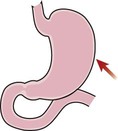 |
body (corporis) | corpor/o, som/o, somat/o |
The largest or most important part of an organ. |
 |
fornix | fornic/o | Any vaultlike or arched structure (pl. fornices). |
 |
fundus | fund/o | The base or deepest part of a hollow organ that is farthest from the mouth of the organ (pl. fundi). |
 |
hilum | hil/o | Recess, exit, or entrance of a duct into a gland, or of a nerve and vessels into an organ (pl. hila). |
 |
lumen | lumin/o | The space within an artery, vein, intestine, or tube (pl. lumina). |
 |
sinus | sin/o, sinus/o | A cavity or channel in bone, a dilated channel for blood, or a cavity that permits the escape of purulent (pus-filled) material (pl. sinuses). Antrum (pl. antra) and sinus are synonyms. |
 |
vestibule | vestibul/o | A small space or cavity at the beginning of a canal. |
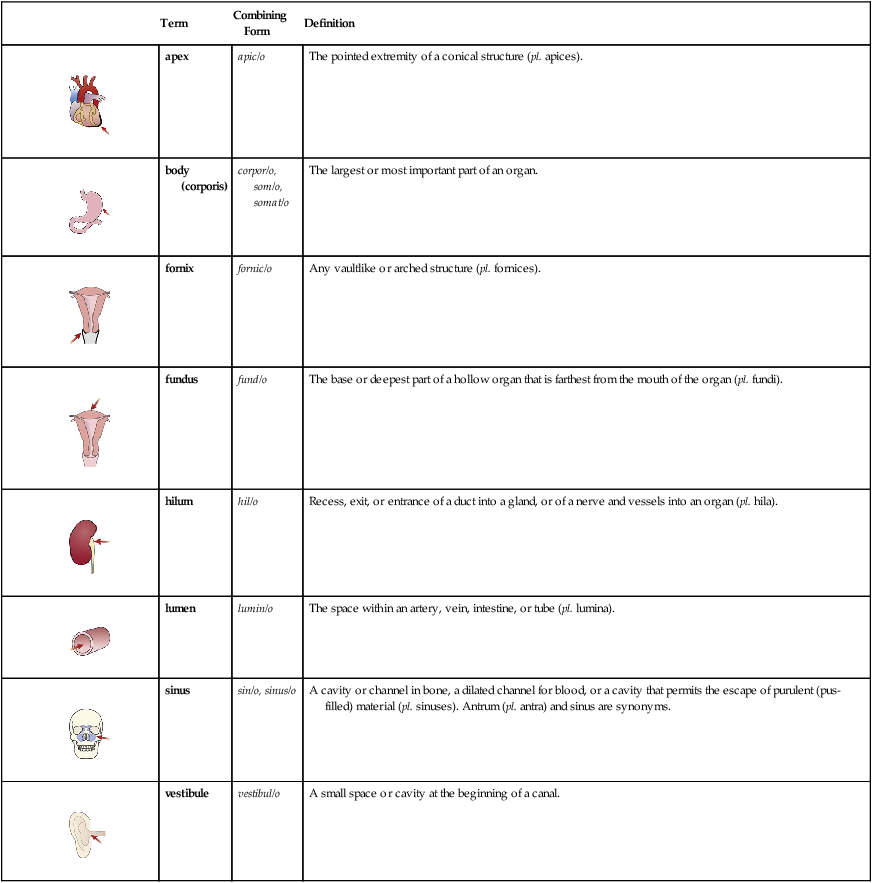


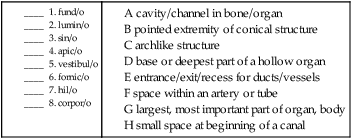
Body Systems
The following table lists each body system and its function.
| Body System | Functions |
| musculoskeletal | Support, movement, protection |
| integumentary | Cover and protection |
| gastrointestinal | Nutrition |
| urinary | Elimination of nitrogenous waste |
| reproductive | Reproduction |
| blood/lymphatic/immune | Transportation of nutrients/waste, protection |
| cardiovascular | Transportation of blood |
| respiratory | Delivers oxygen to cells and removes carbon dioxide |
| nervous/behavioral | Receive/process information |
| special senses (eye and ear) | Information gathering |
| endocrine | Effects changes through chemical messengers |
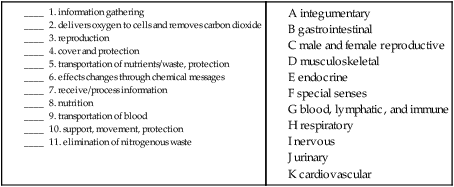
Combining Forms for Body Organization
| Meaning | Combining Form |
| blood | hem/o, hemat/o |
| bone | oste/o, osse/o |
| breakdown, dissolve | lys/o |
| cell | cyt/o, cellul/o |
| epithelium | epitheli/o |
| fat | adip/o, lip/o |
| heart | cardi/o |
| heart muscle | myocardi/o |
| juice | chym/o |
| muscle | my/o, muscul/o |
| nerve | neur/o |
| nipple | thel/e |
| nucleus | kary/o, nucle/o |
| organ, viscera | organ/o, viscer/o |
| same | home/o |
| stroma | strom/o |
| system | system/o |
| to throw, throwing | bol/o |
| tissue | hist/o |
Prefixes for Body Organization
| Prefix | Meaning |
| ana- | up, apart, away |
| cata- | down |
| en- | in |
| endo- | within |
| epi- | above, upon |
| meta- | beyond, change |
| para- | near, beside, abnormal |
Suffixes for Body Organization
| Suffix | Meaning |
| -al, -ous | pertaining to |
| -ia, -ism | condition, state of |
| -on | structure |
| -plasm | formation |
| -some | body |
| -stasis | controlling, stopping |
| -um | structure, thing, membrane |
| -us | structure |
Specialties/Specialists and General Terms
| The levels of organization of the body are accompanied by a number of specialties and their associated specialists. | ||
| Term | Word Origin | Definition |
| cytology | cyt/o cell -logy study of |
The study of the cells. A cytologist specializes in the study of the cell. The suffix -logist means “one who specializes in the study of.” |
| histology | hist/o tissue -logy study of |
The study of tissues. A histologist specializes in the study of tissues. |
| anatomy | ana- up, apart, away -tomy cutting |
To cut apart, the study of the structure of the body. An anatomist specializes in the structure of the body. |
| physiology | physi/o growth -logy study of |
The study of growth; the study of the function of the body. A physiologist specializes in the study of the function of the body. |
| pathology | path/o disease -logy study of |
The study of disease. A pathologist specializes in the study of disease. |
| biopsy | bi/o life, living -opsy viewing |
Process of viewing living tissue that has been removed for the purpose of diagnosis and/or treatment. |
| necropsy | necr/o death, dead -opsy viewing |
Process of viewing dead tissue. |
| autopsy | auto- self -opsy viewing |
Process of viewing by self; term commonly used to describe the examination of a dead body to determine cause(s) of death. |
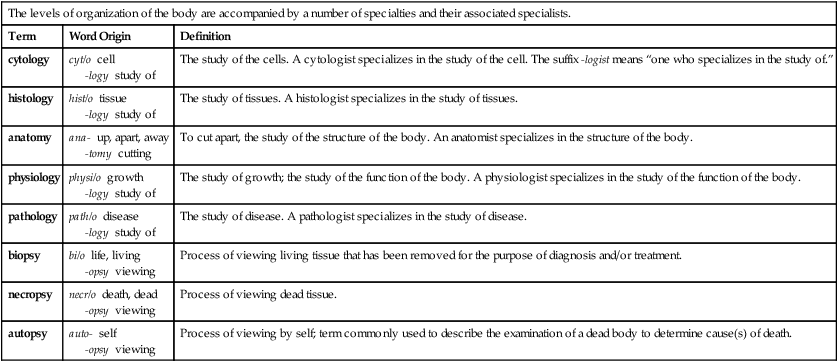

Anatomical Position and Surface Anatomy
Now that you understand the levels of organization of the body, you need the terms that describe locations, positions, and directions on the body. A standard frame of reference, the anatomical position, is the position in which the body stands erect with face forward, arms at the sides, palms forward, with toes pointed forward. This position is used to describe the surface anatomy of the body, both front (ventral) and back (dorsal). Figure 2-2 shows the anatomical position, both front and back, and is labeled with all the surface anatomy labels you will encounter throughout this text.
Ventral Surface Anatomy Terms (Head and Neck)
| Term | Word Origin | Definition |
| buccal | bucc/o cheek -al pertaining to |
Pertaining to the cheek. |
| cephalic | cephal/o head -ic pertaining to |
Pertaining to the head. |
| cervical | cervic/o neck -al pertaining to |
Pertaining to the neck. Collum is a term that refers to the entire neck. |
| cranial | crani/o skull -al pertaining to |
Pertaining to the skull. |
| facial | faci/o face -al pertaining to |
Pertaining to the face. |
| frontal | front/o front –al pertaining to |
Pertaining to the front, the forehead. |
| mental | ment/o chin –al pertaining to |
Pertaining to the chin. |
| nasal | nas/o nose -al pertaining to |
Pertaining to the nose. |
| ocular | ocul/o eye -ar pertaining to |
Pertaining to the eye. |
| oral | or/o mouth -al pertaining to |
Pertaining to the mouth. |
| otic | ot/o ear -ic pertaining to |
Pertaining to the ear. Also called auricular. |
Ventral Surface Anatomy (Trunk)
| Term | Word Origin | Definition |
| abdominal | abdomin/o abdomen -al pertaining to |
Pertaining to the abdomen. |
| axillary | axill/o axilla (armpit) -ary pertaining to |
Pertaining to the armpit. |
| coxal | cox/o hip -al pertaining to |
Pertaining to the hip. |
| deltoid | delt/o triangular -oid resembling |
Pertaining to the deltoid muscle covering the shoulder. The combining form om/o is often used for the shoulder. |
| inguinal | inguin/o groin -al pertaining to |
Pertaining to the groin. |
| mammary | mamm/o breast -ary pertaining to |
Pertaining to the breast. |
| pelvic | pelv/o, pelv/i pelvis -ic pertaining to |
Pertaining to the pelvis. |
| pubic | pub/o pubis -ic pertaining to |
Pertaining to the pubis. |
| sternal | stern/o sternum (breastbone) –al pertaining to |
Pertaining to the breastbone. |
| thoracic | thorac/o chest -ic pertaining to |
Pertaining to the chest. Also called pectoral. |
| umbilical | umbilic/o umbilicus (navel) -al pertaining to |
Pertaining to the umbilicus. |
Ventral Surface Anatomy (Arms and Legs)
| Term | Word Origin | Definition |
| antecubital | ante- forward, in front of, before cubit/o elbow -al pertaining to |
Pertaining to the front of the elbow. |
| brachial | brachi/o arm -al pertaining to |
Pertaining to the arm. Antebrachial means pertaining to the forearm. |
| carpal | carp/o wrist -al pertaining to |
Pertaining to the wrist. |
| crural | crur/o leg -al pertaining to |
Pertaining to the leg. |
| digital | digit/o finger/toe -al pertaining to |
Pertaining to the finger/toe. Phalangeal means pertaining to the bones in the fingers/toes. |
| femoral | femor/o thigh -al pertaining to |
Pertaining to the thigh. |
| manual | man/u hand -al pertaining to |
Pertaining to the hand. |
| palmar | palm/o palm -ar pertaining to |
Pertaining to the palm. Also termed volar. |
| patellar | patell/o, patell/a kneecap -ar pertaining to |
Pertaining to the kneecap. |
| pedal | ped/o foot -al pertaining to |
Pertaining to the foot. |
| plantar | plant/o sole -ar pertaining to |
Pertaining to the sole of the foot. |
| tarsal | tars/o ankle -al pertaining to |
Pertaining to the ankle. |
| Term | Word Origin | Definition |
| acromial | acromi/o acromion -al pertaining to |
Pertaining to the acromion (highest point of shoulder). |
| dorsal | dors/o back -al pertaining to |
Pertaining to the back. |
| gluteal | glute/o buttocks -al pertaining to |
Pertaining to the buttocks. |
| lumbar | lumb/o lower back, loin -ar pertaining to |
Pertaining to the lower back. |
| nuchal | nuch/o neck -al pertaining to |
Pertaining to the neck, especially the back of the neck. |
| olecranal | olecran/o elbow -al pertaining to |
Pertaining to the elbow. |
| perineal | perine/o perineum -al pertaining to |
Pertaining to the perineum. The perineum is the space between the external genitalia and the anus. |
| popliteal | poplite/o back of knee -eal pertaining to |
Pertaining to the back of the knee. |
| sacral | sacr/o sacrum -al pertaining to |
Pertaining to the sacrum. |
| scapular | scapul/o scapula, shoulder blade -ar pertaining to |
Pertaining to the scapula. |
| sural | sur/o calf -al pertaining to |
Pertaining to the calf. |
| vertebral | vertebr/o vertebra, spine -al pertaining to |
Pertaining to the spine. |
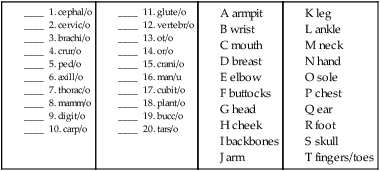
Positional and Directional Terms
Positional and directional terms are used in healthcare terminology to describe up and down, middle and side, and front and back. Because people may be lying down, raising their arms, and so on, standard English terms cannot be used to describe direction. The following table lists directional and positional terms as opposite pairs, with their respective combining forms or prefixes and illustrations. For example, x-rays may be taken from the front of the body to the back—an anteroposterior (AP) view—or from the back to the front—a posteroanterior (PA) view (Figs. 2-3 and 2-4). The midline of the body is an imaginary line drawn from the crown of the head down between the eyes, through the chest, and separating the legs.
Positional and Directional Terms
| Term | Word Origin | Definition | |
 |
anterior (ant) ventral |
anter/o front -ior pertaining to ventr/o belly -al pertaining to |
Pertaining to the front. Pertaining to the belly side. |
 |
posterior (pos) dorsal |
poster/o back -ior pertaining to dors/o back -al pertaining to |
Pertaining to the back. Pertaining to the back of the body. |
 |
superior (sup) cephalad |
super/o upward -ior pertaining to cephal/o head -ad toward |
Pertaining to upward. Toward the head. |
 |
inferior (inf) caudad |
infer/o downward -ior pertaining to caud/o tail -ad toward |
Pertaining to downward. Toward the tail. |
 |
medial | medi/o middle -al pertaining to |
Pertaining to the middle (midline). |
 |
lateral (lat) | later/o side -al pertaining to |
Pertaining to the side. |
 |
ipsilateral | ipsi- same later/o side -al pertaining to |
Pertaining to the same side. |
 |
contralateral | contra- opposite later/o side -al pertaining to |
Pertaining to the opposite side. |
 |
unilateral | uni- one later/o side -al pertaining to |
Pertaining to one side. |
 |
bilateral | bi- two later/o side -al pertaining to |
Pertaining to two sides. |
 |
superficial (external) | On the surface of the body. | |
 |
deep (internal) | Away from the surface of the body. | |
 |
proximal | proxim/o near -al pertaining to |
Pertaining to near the origin. |
 |
distal | dist/o far -al pertaining to |
Pertaining to far from the origin. |
 |
dextrad* | dextr/o right -ad toward |
Toward the right. |
 |
sinistrad* | sinistr/o left -ad toward |
Toward the left. |
 |
afferent | af- toward fer/o to carry -ent pertaining to |
Pertaining to carrying toward a structure. |
 |
efferent | ef- away from fer/o to carry -ent pertaining to |
Pertaining to carrying away from a structure. |
 |
supine | Lying on one’s back. | |
 |
prone | Lying on one’s belly. |
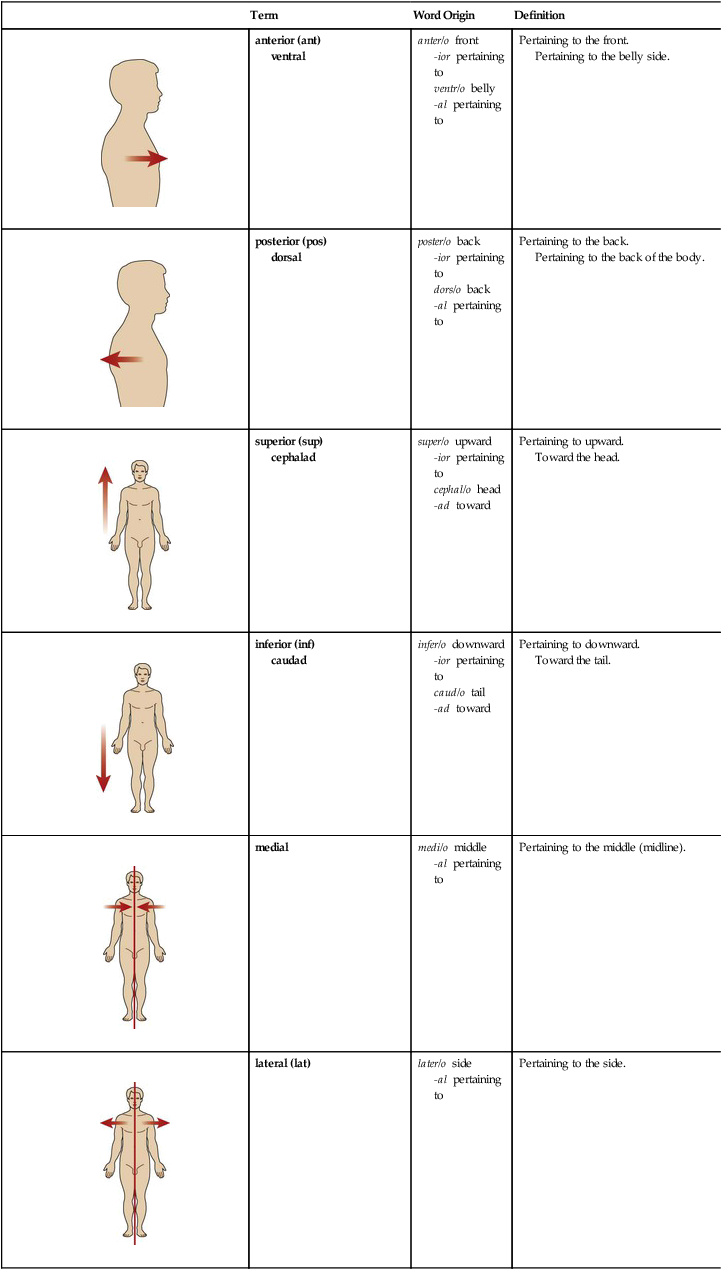
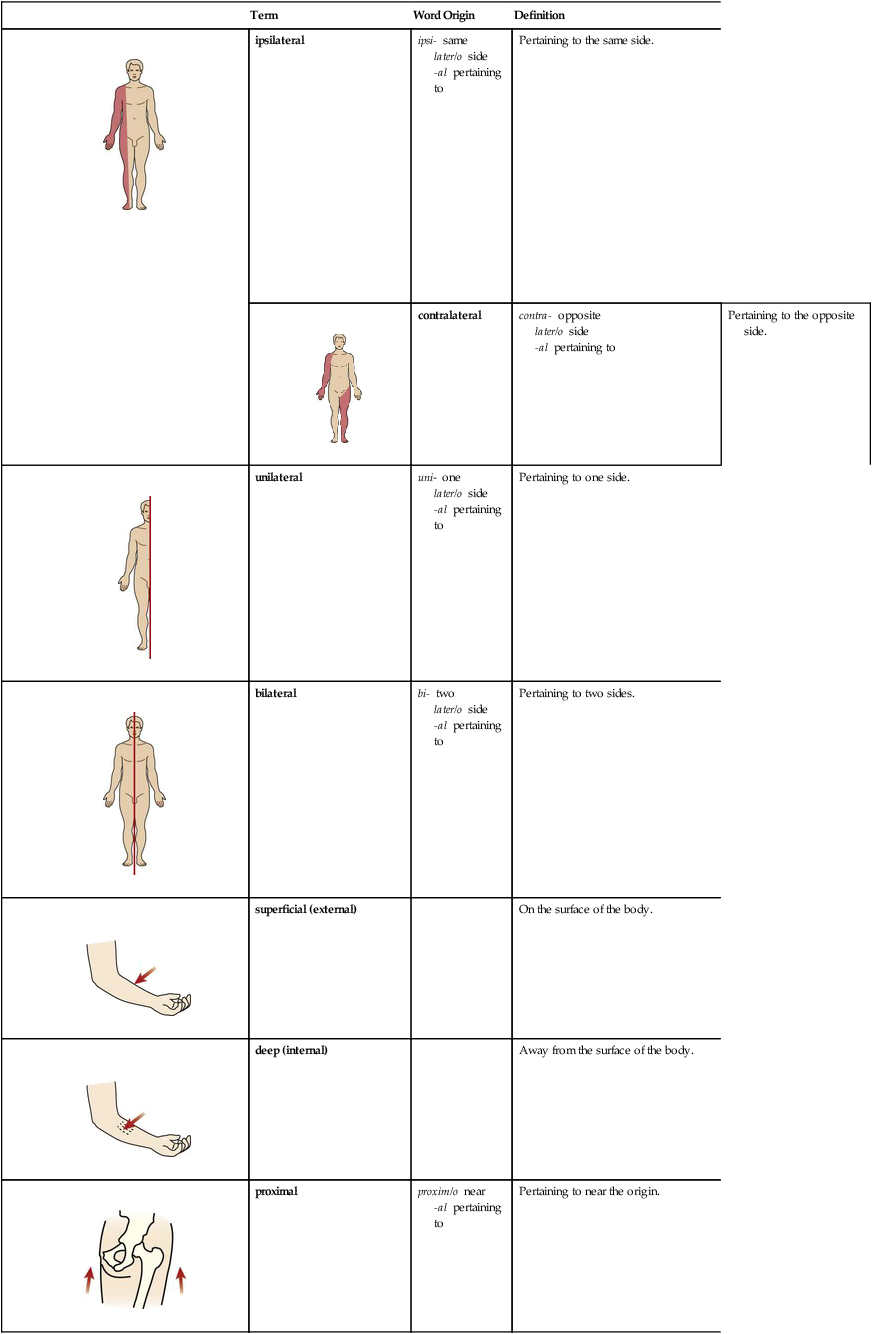
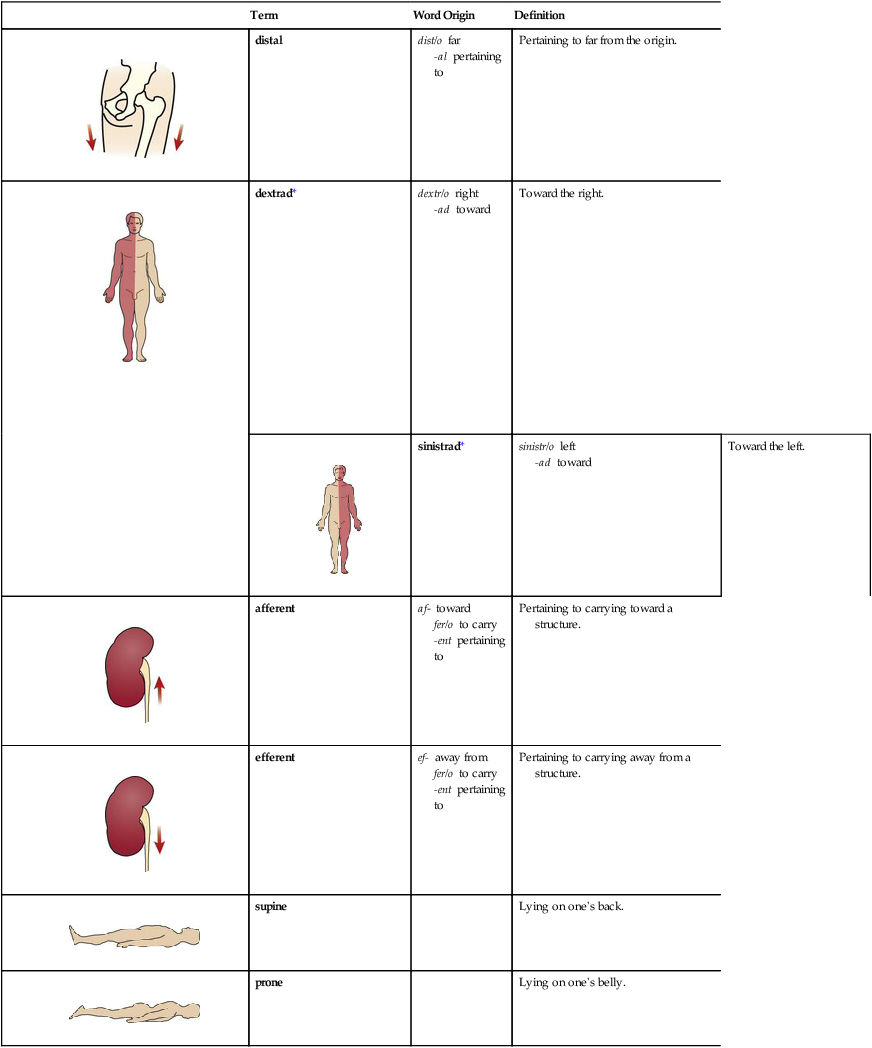
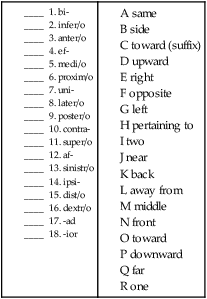
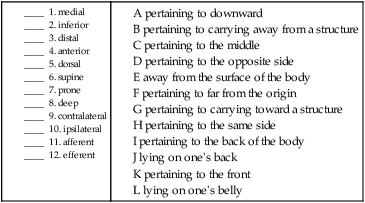
Body Cavities
The body is divided into five cavities (Fig. 2-5). Two of these five cavities are in the back of the body and are called the dorsal cavities. The other three cavities are in the front of the body and are called the ventral cavities. Most of the body’s organs are in one of these five body cavities.

Body Regions
Abdominopelvic Regions
The abdominopelvic regions are the nine regions that lie over the abdominopelvic cavity (Fig. 2-6). The area in the center of the abdominopelvic region is called the umbilical area. Laterally, to the left and right of this area, are the lumbar regions. They are called the lumbar regions because they are bound by the lumbar vertebrae. Superior to the lumbar regions, and below the ribs, are the hypochondriac regions. Medial to the hypochondriac regions, and superior to the umbilical region, is the epigastric region. Inferior to the umbilical region is the hypogastric region, and lateral to the sides of the hypogastric region are, respectively, the right and left iliac regions, sometimes referred to as the inguinal regions.
Abdominopelvic Quadrants
A simpler method of naming a location in the abdominopelvic area is to divide the area into quadrants, using the navel as the intersection. These quadrants are referred to as either right or left, upper or lower (Fig. 2-7). In the right upper quadrant (RUQ) lies the liver. In the left upper quadrant (LUQ) lie the stomach and the spleen. The appendix is in the right lower quadrant (RLQ). If a patient complains of pain in the area of McBurney’s point, the area that is approximately two thirds of the distance between the navel and the hip bone in the RLQ, appendicitis is suspected. Except for the appendix, the left lower quadrant (LLQ) contains organs similar to the lower right. In the LLQ, halfway between the navel and the hip bone, is Munro’s point. This is a standard site of entrance for surgeons who perform laparoscopic surgery.
Planes of the Body
Another way of describing the body is by dividing it into planes, or flat surfaces, that are imaginary cuts or sections through the body. The use of plane terminology is common when imaging of internal body parts by computed tomography (CT) scans, magnetic resonance imaging (MRI), positron emission tomography (PET) scans, or other imaging techniques is described. Figs. 2-8 to 2-10 show the three body planes and corresponding views of the brain.
Sagittal planes are vertical planes that separate the sides from each other (see Fig. 2-8). A midsagittal plane, also termed the median plane, separates the body into equal right and left halves. The frontal (or coronal) plane divides the body into front and back portions (see Fig. 2-9). The transverse plane (also called cross-sectional) divides the body horizontally into an upper part and a lower part (see Fig. 2-10). And finally, the oblique plane, not as commonly used as the first three, divides the body at a slanted angle.
Combining Forms for Body Cavities, Abdominopelvic Quadrants and Regions, and Planes
| Meaning | Combining Form |
| abdomen | abdomin/o, celi/o, lapar/o |
| back | dors/o |
| cartilage | chondr/o |
| cranium (skull) | crani/o |
| diaphragm | diaphragmat/o, diaphragm/o, phren/o |
| front, bellyside | front/o, ventr/o |
| groin | inguin/o |
| ileum | ile/o |
| ilium | ili/o |
| lower back, loin | lumb/o |
| mediastinum | mediastin/o |
| organ | viscer/o, organ/o |
| pelvis | pelv/i, pelv/o |
| peritoneum | peritone/o |
| pleura | pleur/o |
| spine | spin/o |
| sternum | stern/o |
| stomach | gastr/o |
| thorax (chest) | thorac/o |
| umbilicus (navel) | umbilic/o, omphal/o |
| vertebra | vertebr/o |
| wall | pariet/o |
Prefixes for Body Cavities, Abdominopelvic Quadrants and Regions, and Planes
| Prefix | Meaning |
| epi- | above, upon |
| hyper- | excessive, above |
| hypo- | deficient, below, under |
| mid- | middle |
| trans- | through, across |
| Abbreviation | Definition |
| ant | anterior |
| AP | anteroposterior |
| CT | computed tomography |
| inf | inferior |
| lat | lateral |
| LLQ | left lower quadrant |
| LUQ | left upper quadrant |
| MRI | magnetic resonance imaging |
| PA | posteroanterior |
| PET | positron emission tomography |
| pos | posterior |
| RLQ | right lower quadrant |
| RUQ | right upper quadrant |
| sup | superior |






